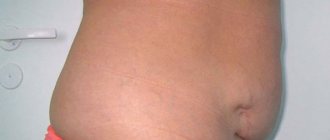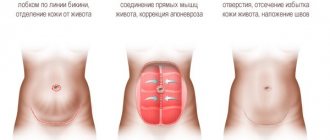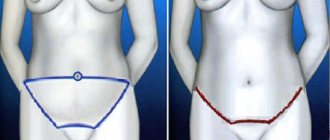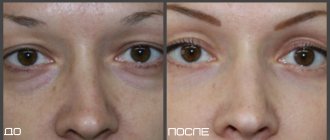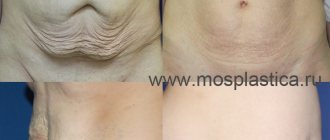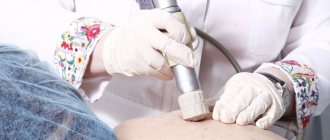A handful of love (poignée d'amour) is what the French romantics call the touching folds on the belly of the woman they love. Alas, the further we are from France and the greater the volume of fatty tissue on the abdomen, the less inclined those around us are to be touched by our poignée d'amour.
A large saggy belly can thoroughly ruin the life of its owner, be it a woman or a man. No matter how you disguise it with clothes, you can’t hide it. And in a bathing suit the look becomes completely grotesque. At the same time, even a quite slender person can have a protruding belly. And neither diet nor exercise helps to cope with it.
Why is this happening? The fact is that with significant tissue deformation (after pregnancy, severe weight loss or for other reasons), the anterior abdominal wall weakens and hangs in the form of a so-called skin-fat “apron”.
It is not surprising that with the advent of abdominoplasty - tummy tuck surgery - those with unaesthetic bellies perked up and began to actively resort to this surgical procedure.
Lady Gaga, Kim Kardashian, Britney Spears, Sharon Osbourne and even the great Al Pacino - these Western stars do not hide the fact that they once had tummy tuck surgery. It is gratifying that today it is not only “celebrities” who can correct annoying flaws in appearance - prices for abdominoplasty in Moscow do not exceed the capabilities of an ordinary person.
1
Consultation with a plastic surgeon before abdominoplasty
2 Consultation with a plastic surgeon before abdominoplasty
3 Consultation with a plastic surgeon before abdominoplasty
How and why abdominoplasty is performed
First of all, it should be noted that abdominoplasty is not a treatment for obesity and is not an option for liposuction. Although it is quite possible to simultaneously perform a tummy tuck and liposuction, such operations, called simultaneous, are performed at the request of the patient.
Tummy tuck or tummy tuck is an operation that improves the overall aesthetics of the abdomen by restoring tissue tone, removing excess fat and skin tissue, and correcting cosmetic defects in the skin.
Indications for abdominoplasty
We list the typical indications for abdominoplasty:
- abdominal deformation due to pregnancy and childbirth;
- saggy belly, excess skin tissue due to significant weight loss, hormonal or metabolic imbalance;
- rough postoperative scars, stretch marks (striae) on the abdomen;
- umbilical hernia;
- diastasis (divergence) of the rectus abdominal muscles;
- violation of muscle tone of the anterior abdominal wall;
- the need for a simultaneous tummy tuck and liposuction is improving.
Abdominoplasty has proven its effectiveness for patients of any age and gender.
Absolute and relative contraindications to surgery include: cancer, cardiovascular pathologies, coagulation disorders, diabetes mellitus, infectious and inflammatory diseases, age under 18 years.
Important! Abdominoplasty is not recommended for women planning pregnancy and childbirth in the coming years.
Classic abdominoplasty
This type of surgical intervention is the most radical of all; it involves extensive redistribution of tissue and affects all areas of the abdomen. Classic abdominoplasty is well combined with liposuction or scar plastic surgery, allowing you to simultaneously solve a range of problems.
The intervention is carried out through two approaches - around the navel and along the lower abdomen. The doctor consistently separates and excises excess fatty tissue and skin, eliminates scar stretch marks, tightens and strengthens weakened muscles, and tightens loose ones. Then comes the formation of a new aesthetic umbilical area.
At the end of the operation, drainage is installed, sutures and a fixing bandage are applied.
The operation lasts about 2-3 hours, general anesthesia is used.
Classic abdominoplasty helps create a new slender silhouette with a toned stomach and a slender waist.
Abdominoplasty. Photo before:
1 BEFORE abdominoplasty
2 BEFORE abdominoplasty
3 BEFORE abdominoplasty
Abdominoplasty. Photo after:
1 AFTER abdominoplasty
2 AFTER abdominoplasty
3 AFTER abdominoplasty
Trust abdominoplasty in Chelny to professionals
If you need abdominoplasty, then the price at the center of plastic surgery and cosmetology is determined taking into account the experience of the surgeon, the chosen method of intervention and the type of anesthesia.
Wellness Clinic clients are guaranteed to receive:
- attentive service from qualified staff;
- assistance from surgeons with extensive experience who regularly study new technologies and undergo internships;
- modern techniques and equipment, which makes it possible to simplify the rehabilitation period and minimize the risk of complications;
- the desired result that will last for a long period of time.
If you decide to have abdominoplasty, photos and reviews from satisfied clients will allow you to be convinced of the effectiveness of the service. To learn more about surgical intervention, sign up for a consultation using the online form or by phone: +7 965-621-68-68.
Prices for abdominoplasty
| Name of procedure | Cost ( in rubles) |
| Classic abdominoplasty of 1st category of complexity | 123000 |
| Classic abdominoplasty of 2nd category of complexity | 155000 |
| Classic abdominoplasty 3rd category of complexity | 192000 |
| Miniabdominoplasty 1st category of complexity | 70000 |
| Miniabdominoplasty 2nd category of complexity | 89000 |
| Miniabdominoplasty 3rd category of complexity | 98000 |
Abdominoplasty through a vertical incision
As the name of the technique suggests, the incision is made not along the lower abdomen, but along its midline. This type of surgery is sometimes called “male surgery”, since in the stronger sex fat accumulations are often localized in the upper abdomen.
The operation allows you to remove excess fat and sagging skin and restore the aesthetic appearance of the body. Vertical abdominoplasty is less traumatic than classical abdominoplasty due to the smaller intervention area. The serious disadvantages of the technique include a fairly noticeable postoperative scar.
Mini abdominoplasty
It is a more gentle type of tummy tuck - without navel transfer. The technique is usually recommended for patients with a small apron of skin and fat in the lower abdomen and skin lacking tone. For example, for ladies after childbirth or after losing weight. Mini abdominoplasty is not suitable for people with fat deposits above the navel, as well as with significant violations of the tone of the abdominal muscles.
The operation is performed through a small incision along the bikini line. During this intervention, excess skin and fat is removed and the abdominal muscles are tightened below the navel level. Mini abdominoplasty can be successfully combined with abdominal liposuction.
How is abdomen removed?
3. View of the patient before removal of the abdomen on the operating table: the line of the skin incision above the pubis and the line of preliminary marking of the skin of the intended area for removing the skin-fat flap are marked (the line above the navel).
4. An incision in the skin of the anterior abdominal wall to perform aspiration of adipose tissue for subsequent use for lipofilling of the legs.
5. Abdominal removal surgery: the stage of infiltration of subcutaneous fat with a special solution, which contains anesthetics, saline and adrenaline in certain proportions. The latter causes vasospasm, which helps reduce bleeding.
6. Tissue infiltration is complete.
7. Stage of fat aspiration from the anterior abdominal wall. In this case, the negative pressure (vacuum) should be significantly less than with standard liposuction (to better preserve the integrity of fat cells - the second stage is planned to carry out lipofilling of the legs).
8. The stage of aspiration of adipose tissue from the anterior abdominal wall is completed.
9. Abdominoplasty: Beginning of the abdominal skin incision to perform the abdominoplasty.
10. A skin incision is made along the intended line. Quite rarely, the length of the incision is shorter. Unreasonable attempts to reduce the length of the incision can lead to the formation of so-called “dog ears” (overhanging skin folds along the edges of the incision).
11. Beginning of detachment of the skin-fat “apron”. The tweezers indicate Scarpa's fascia (whitish in color), which separates the superficial and deep fatty layers. Strict adherence to the principle of detachment over this fascia makes it possible not only to carry out detachment easily and practically bloodlessly, but also, most importantly, to preserve the perforating arteries that supply the skin-fat flap.
12. The skin-fat “apron” is peeled off to the level of the navel. The “new” diameter of the external opening of the future navel is marked in the form of a circle, which will subsequently take on the appearance of an oval due to skin tension.
13. Before the incision is made, the skin around the navel is infiltrated with a solution. This helps to make a correct and precise skin incision in this area.
14. A special sharp single-prong hook is used to cut the skin around the navel, which significantly reduces skin trauma.
15. The navel is isolated on the umbilical cord - this manipulation must be carried out very carefully, together with the surrounding fatty tissue, in the thickness of which the feeding vessels pass. Otherwise, with aggressive “exposure” of the umbilical cord after surgery, the navel will “hurt and suffer,” even to the point of necrosis.
16. Removal of the abdomen: the stage of dissection along the midline of the isolated skin-fat “apron” to facilitate further detachment above, to the level of the 12 ribs and the xiphoid process.
17. The lower flap is cut until it connects with the incision around the navel. The navel on the umbilical cord is hooked in a certain place on the thread “holder” for precise control and prevention of torsion of the leg during its subsequent stitching.
18. Abdominal removal operation: the stage of tissue detachment above the navel to the level of the xiphoid process and 12 ribs is completed. The inner edges of the rectus abdominis muscles are marked: diastasis (divergence) is about 5-6 cm at the point of maximum divergence.
19. The stage of suturing the aponeurosis to eliminate diastasis of the rectus abdominis muscles.
20. Removal of the abdomen: in the lower abdomen (below the navel), 2 rows of sutures with non-absorbable thread are completed (1st row - separate interrupted sutures, 2nd row - continuous suture). Stitching the upper “floor” of the aponeurosis (fascia) covering the rectus abdominis muscles.
21. It is shown how close the edges of the separated rectus abdominis muscles are.
22. Abdominal removal operation: final view of the aponeurosis stitched along the midline - from the xiphoid process to the pubis, leaving a small space for the umbilical cord. It is necessary to carefully preserve intact the vessels that supply the detached skin-fat flap, emanating from the intercostal arteries in the upper floor of the abdomen. Therefore, the zone of tissue detachment in its upper part is mainly only in the central region (the picture looks like a narrow tunnel). Excessively wide detachment on the sides can lead to disruption of the trophism (vascular nutrition) of the detached skin-fat flap with corresponding negative consequences (see comments to paragraphs 11 and 15).
23. Shown is a special hook for abdominoplasty, bearing the name of its inventor - the famous Brazilian surgeon Osvaldo Saldanha, the author of the modern “lipoabdominoplasty” technique, which we use most often in our practice. This “cunning” hook allows for maximum visibility for the surgeon, but also, of course, greatly facilitates the assistant’s functions.
24. Removal of the abdomen: the main stage of “internal restoration” is completed. The length of the umbilical cord is usually reduced (corresponding to the thickness of the subcutaneous fat) by fixing it to the aponeurosis with separate interrupted sutures (to prevent its bulging in the umbilical ring).
25. The detached skin-fat flap of the anterior abdominal wall is stretched downward and fixed along the midline to the center of the lower edge of the incision. A special tool is shown - a navel marker (again, an invention of Brazilian surgeons). It allows you to absolutely accurately transfer the projection of the navel to the anterior abdominal wall.
26. Abdominal removal operation: the navel is inserted into the marker hole under the skin-fat flap, and the upper part of the instrument (pointed nose), when pressed, leaves a “point” on the skin of the anterior wall of the abdomen - a projection of the future navel.
27. In the projection of the future navel on the front wall of the abdomen, a “circle” of the surface layer of skin is removed (deepithelialization), then inside this “circle” incisions are made to form 4 triangles - “petals”.
28. Removal of the abdomen: the tops of these triangles - “petals” will be pulled inward and fixed with a thread to the aponeurosis around the umbilical cord. Thus, an umbilical recess is formed - a fossa.
29. Before forming the umbilical cavity and fixing the “triangles”, adipose tissue is cut out in the new opening of the navel (in the form of a funnel).
30. Abdominal removal operation: after the umbilical recess is formed, the navel itself is brought into the hole, the skin edges of which are sutured to the edges of the “new” umbilical hole. Next, excess skin-fat flap is excised along the boundaries marked with a marker.
31. Excess skin-fat flap of the abdomen is excised. After which the edges of the wound are stitched together in several rows.
32. Abdominal removal: final appearance at the end of the operation. Removable cosmetic sutures are placed on the skin. Drains must be left in place to drain the ichor after surgery.
The result of the operation “Removal of the abdomen and abdominoplasty.” Photos before and after.
Endoscopic abdominoplasty
This gentle type of tummy tuck is not suitable for men and women with significant sagging skin on the abdomen. But it can be recommended as a tummy tuck after childbirth for patients without excess weight and problems with sagging skin, but with weakened muscles of the anterior abdominal wall.
The aesthetic contour of the abdomen is created by suturing the edges of the rectus muscles. Endoscopic abdominoplasty is the most gentle and minimally invasive, since all manipulations are performed with special instruments through small incisions around the navel or above the pubis. The duration of the operation is 1-2 hours, the rehabilitation period is short
Abdominoplasty. Photo before:
1 BEFORE abdominoplasty
2 BEFORE abdominoplasty
3 BEFORE abdominoplasty
Abdominoplasty. Photo after:
1 AFTER abdominoplasty
2 AFTER abdominoplasty
3 AFTER abdominoplasty
Abdominoplasty: photos before/after surgery
Qualified Wellness Clinic surgeons perform abdominoplasty in Chelny to solve the following problems:
- removal of excess folds to form an ideal waist - you should not compare this surgical intervention with liposuction, these are completely different operations;
- severe stretching of the skin due to loss of elasticity, which can occur after severe weight loss or childbirth;
- sagging belly after rapid weight loss of a large number of kilograms;
- excessive amount of subcutaneous fat layer that cannot be removed in any other way;
- sagging of the abdominal wall;
- stretching or separation of abdominal muscles;
- a large number of scars, scars or stretch marks resulting from injuries, operations;
- umbilical, inguinal and other types of hernias.
After abdominoplasty
Typically, a person remains under observation in the hospital for a day after surgery.
After discharge, the patient comes to the clinic for dressings. You can start working in 2-3 days. After 10-12 days, the sutures can be removed (if non-absorbable suture material was used).
The result of abdominoplasty is obvious almost immediately, but this does not mean that the patient can take rehabilitation recommendations lightly. So, it is necessary to remember that for 1 month after surgery you need to wear special compression hosiery, which fixes the tissues in the new position, reduces swelling and speeds up healing.
For several months (on average, from 3 to 5), while the final healing of the abdominal tissues occurs after abdominoplasty, it is necessary to refrain from physical activity, warming and contrasting water procedures, and visits to the solarium.
Preparing for surgery
During a preliminary consultation in our clinic, the plastic surgeon determines the scope of the intervention and clarifies how much abdominoplasty costs. When the date of the operation is set, the plastic surgeon gives specific recommendations for preparing for the intervention. First of all, it is necessary to stop smoking and drinking alcohol, this has an extremely negative effect on the tissue healing process. It is imperative to inform your doctor about all medications you are taking. Your doctor may stop some of them, such as certain blood thinners.
In addition, before the operation you should try to lose as much weight as possible so that the effect is more lasting and pronounced.
It is important to undergo a series of tests and undergo several instrumental tests to rule out health problems. These include blood and urine tests, determination of blood group and Rh, taking an ECG and performing fluorography. Additionally, consultations with a therapist and anesthesiologist are required.
To do or not to do abdominoplasty?
The decision to have surgery can be made by you and only you. But if you have not been happy with your own reflection in the mirror for a long time, you have problems with choosing clothes or, even worse, with tying your shoelaces, you do not risk undressing in the light even in front of a loved one, tummy tuck will help solve all these problems. For our part, we offer an individual approach, skill and experience, expert equipment and reasonable prices.
MedicCity employs talented plastic surgeons with enormous experience in successfully performing plastic surgeries of any level of complexity! With us you can undergo a comprehensive preoperative examination, receive consultations from specialists in various fields, and perform the necessary plastic surgeries: blepharoplasty, circular facelift, liposuction, buttock, thigh lift and others. Come to our clinic and see for yourself!
